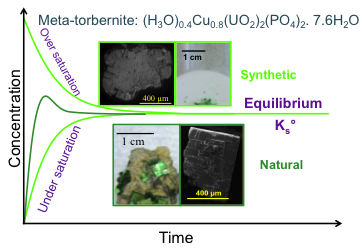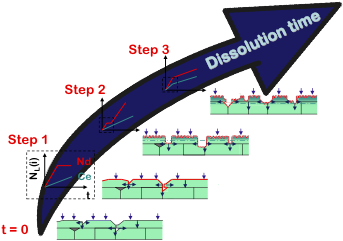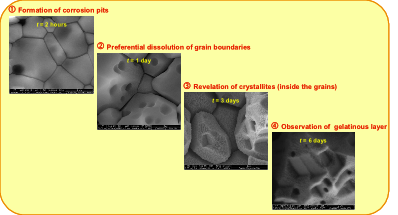
Stéphanie Szenknect
| Chercheur CEA/DEN Tel: 04 66 79 52 12 Fax: 04 66 79 76 11 e-mail: stephanie.szenknect ad cea.fr |
 |
| Since 2010 | CEA Research engineer at ICSM (Nuclear Energy Division) Understanding of physico-chemical phenomena located at the solid/liquid interface of materials in dissolution: thermodynamic and kinetic aspects. |
| 2005 – 2010 | CEA Research engineer, Technological Research Division, NanoChemistry and NanoSafety Laboratory (Grenoble, France) Understanding of physico-chemical phenomena located at the solid/liquid interface of materials in dissolution: thermodynamic and kinetic aspects. |
| 2003 – 2005 | Postdoctoral Fellow, CEA / Technological Research Division, Tracing Technologies Laboratory (Grenoble, France) Reactive transport in natural porous media. Experiments and modelling for environmental applications. |
| 2000 – 2003 | Ph.D in Earth Sciences (geochemistry and hydrogeology), Institute of Radioprotection and Nuclear Safety (IRSN), Department of Environmental Radioprotection (Fontenay aux Roses, France) Collaboration with LTHE (UMR 5564), under the supervision of Dr. J.-P. Gaudet. |
Size-and concentration-dependent deposition of fluorescent silica colloids in saturated sand columns: transport experiments and modeling
Vitorge, E.; Szenknect, S.; Martins, J. M.; Gaudet, J.-P., Environmental Science: Processes Impacts 2013.
From Uranothorites to Coffinite: A Solid Solution Route to the Thermodynamic Properties of USiO4
Szenknect, S.; Costin, D. T.; Clavier, N.; Mesbah, A.; Poinssot, C.; Vitorge, P.; Dacheux, N., Inorganic Chemistry 2013, 52, 6957-6968.
Purification of uranothorite solid solutions from polyphase systems
Clavier, N.; Szenknect, S.; Costin, D. T.; Mesbah, A.; Ravaux, J.; Poinssot, C.; Dacheux, N., Journal of Nuclear Materials 2013, 441, 73-83.
Kinetics of Structural and Microstructural Changes at the Solid/Solution Interface during Dissolution of Cerium (IV)–Neodymium (III) Oxides
Szenknect, S. p.; Mesbah, A.; Horlait, D.; Clavier, N.; Dourdain, S.; Ravaux, J.; Dacheux, N., The Journal of Physical Chemistry C 2012, 116, 12027-12037.
Dissolution of Cerium(IV)–Lanthanide(III) Oxides: Comparative Effect of Chemical Composition, Temperature, and Acidity
Horlait, D.; Clavier, N.; Szenknect, S.; Dacheux, N.; Dubois, V., Inorganic Chemistry 2012, 51, 3868-3878.
Effects of water content on reactive transport of Sr-85 in Chernobyl sand columns
Szenknect, S.; Ardois, C.; Dewiere, L.; Gaudet, J. P., Journal of Contaminant Hydrology 2008, 100, 47-57.
Sorption isotherms: A review on physical bases, modeling and measurement
Limousin, G.; Gaudet, J.-P.; Charlet, L.; Szenknect, S.; Barthes, V.; Krimissa, M., Applied Geochemistry 2007, 22, 249-275.
Collaboration with: Dr. M. Descostes (AREVA, BG-Mines), Dr. C. Poinssot (CEA/DMRC), Pr. R.C. Ewing (CISAC, Stanford University).
Financial support from: NEEDS Ressources, CEA/NOPRA project, AREVA BG Mines
The determination of the thermodynamic data associated with uranium and thorium bearing phases appears to be a crucial step toward understanding the origin of actinides deposits or to forecast the fate and transport of actinides in natural media. A parallel approach based on the study of both synthetic and natural samples is set up to evaluate the solubility constants. The solubility constants are determined after a thorough characterization of the solid phases in both under- and supersaturated conditions. The joint determination of Gibbs free energy then allows the calculation of ΔRH°(298 K) and ΔRS°(298 K). From these values, the thermodynamic data associated with the formation of the phases can be also evaluated and compared with those obtained by different techniques such as calorimetry, showing the reliability of the method developed. Finally, the data obtained can be implemented in a calculation code to determine the stability domains of the phases in environmental conditions typical of a former mining site.
 |  |
Collaboration with: ICSM/LME, ICSM/LDD, Dr. Andréa Salvatores (CEA/DRCP)
Financial support from: CEA/PAREC project, ANR COMPACT
Improving the understanding of dissolution mechanisms at the solid/solution interface of uranium and thorium based mixed oxides is a critical step in the frame of Gen IV nuclear fuel elements that integrates minor actinides recycling. In order to give significant insight into the dissolution kinetics of sintered samples of (AnIV,LnIII) mixed oxides, the in operando characterisation of the evolving solid/solution interface is performed using several techniques: X-Ray Reflectivity (XRR), Grazing Incidence X-Ray Diffraction (GI-XRD), and ESEM. The aim is to characterize the microstructural and structural changes of the solid/solution interface and to couple these results with solution analysis.
 |  |